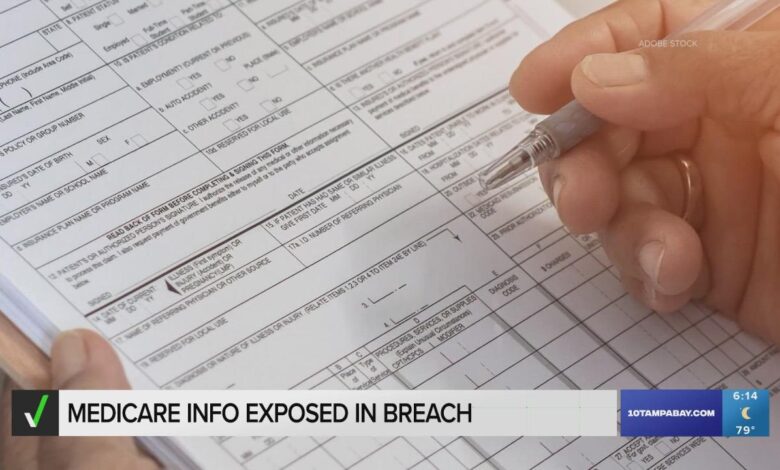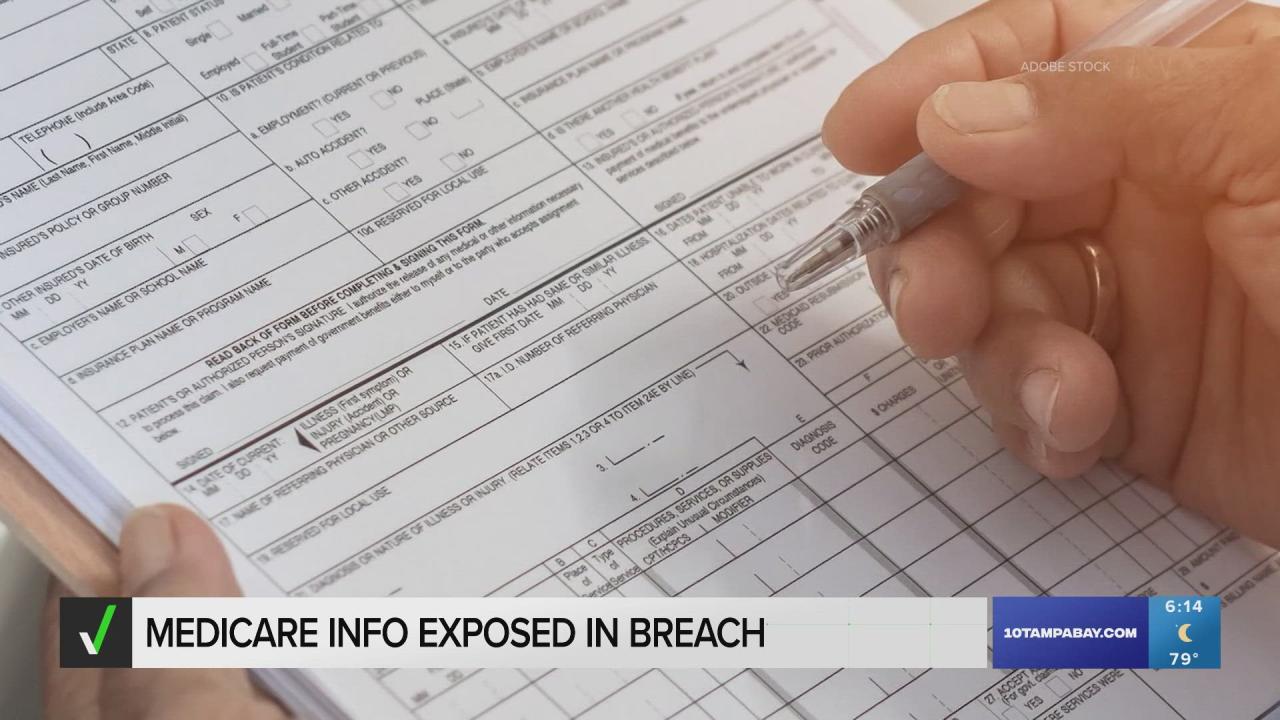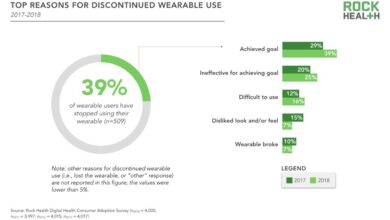
612K Medicare Beneficiaries Affected by MoveIt Data Breach
612K Medicare beneficiaries affected MoveIt data breach – that’s a staggering number. This massive data breach, exposing sensitive personal information of hundreds of thousands of Medicare recipients, raises serious concerns about the security of our healthcare data. We’ll delve into the specifics of the breach, explore the vulnerabilities exploited, and examine the potential consequences for those affected. This isn’t just a tech story; it’s a story about the real-world impact of data insecurity on vulnerable individuals.
The scale of this breach is truly alarming. The compromised information included not only names and addresses but also potentially far more sensitive data like Social Security numbers and medical records. The implications for identity theft and medical fraud are significant, and the long-term effects on both individual beneficiaries and the public’s trust in healthcare data security are yet to be fully understood.
We’ll look at what happened, how it happened, and what we can learn from this devastating event.
The Scale of the Data Breach
The MoveIt data breach, impacting 612,000 Medicare beneficiaries, represents a significant event in the ongoing struggle to protect sensitive health information. The sheer number of individuals affected underscores the vulnerability of large healthcare systems to sophisticated cyberattacks and the devastating consequences for patients. This breach highlights the urgent need for improved data security measures across the healthcare industry.The compromise of 612,000 Medicare beneficiaries’ data is a serious matter with far-reaching implications.
The scale of this breach necessitates a thorough examination of its impact and the steps needed to prevent similar incidents in the future. The potential for identity theft, medical fraud, and financial losses for those affected is substantial, demanding swift and comprehensive remediation efforts.
Types of Compromised Personal Information
The MoveIt breach exposed a range of sensitive personal information belonging to the affected Medicare beneficiaries. This included personally identifiable information (PII) such as names, addresses, dates of birth, and Social Security numbers. In addition, the breach potentially exposed Medicare identification numbers, medical records, and other health information. The breadth of the compromised data significantly increases the risk of identity theft and other forms of fraud for the affected individuals.
Comparison to Other Significant Healthcare Data Breaches
The MoveIt breach ranks among the largest healthcare data breaches in recent history. While precise comparisons are difficult due to variations in reporting and data disclosed, this breach’s impact on a large number of Medicare beneficiaries places it alongside other notable incidents, such as the Anthem breach in 2015 (affecting approximately 80 million individuals) and the Premera Blue Cross breach in 2015 (affecting approximately 11 million individuals).
The recent MoveIt data breach impacting 612,000 Medicare beneficiaries is a serious blow to patient trust. It makes you wonder about the security of sensitive health information, especially given the CMS is simultaneously launching new initiatives like their primary care Medicare model ACO, as detailed in this article: cms launches primary care medicare model aco. Hopefully, increased focus on primary care will also translate to improved data security practices for those 612,000 affected individuals.
These events, along with the MoveIt breach, collectively highlight the persistent and evolving threat landscape facing the healthcare sector.
Timeline of Events
The timeline of the MoveIt breach, from discovery to public disclosure, is crucial for understanding the response and potential lessons learned. While specific dates may vary depending on the source, a general timeline might include the initial discovery of the breach by the affected organization, the investigation process to determine the extent of the compromise, the notification of affected individuals, and the public disclosure of the incident.
Understanding this timeline allows for a better assessment of the response time and the effectiveness of communication strategies employed.
MoveIt Vulnerability and Exploitation

Source: keymedia.com
The MoveIt Transfer data breach affecting 612,000 Medicare beneficiaries highlights a critical vulnerability in widely used file transfer software. Understanding the specific weaknesses exploited and the attackers’ methods is crucial to preventing future incidents. This section details the vulnerabilities, attack methods, and potential motivations behind the breach.The attackers leveraged a vulnerability in the MoveIt Transfer application, specifically a SQL injection flaw.
This flaw allowed malicious actors to inject SQL commands into the application’s input fields, effectively gaining unauthorized access to the database. This wasn’t a zero-day exploit; rather, it was an already known vulnerability that hadn’t been patched by all users of the software. The vulnerability allowed the attackers to bypass security measures and manipulate database queries, leading to data exfiltration.
Attack Methods and Data Exfiltration
The attackers likely used automated tools to scan for vulnerable MoveIt Transfer instances across the internet. Once a vulnerable system was identified, they injected malicious SQL commands to gain access to the database. The data exfiltration likely involved multiple stages. First, the attackers obtained database credentials or exploited the vulnerability to directly access the database. Second, they identified tables containing sensitive beneficiary data.
Finally, they downloaded the data, possibly using tools to compress and encrypt the stolen information for easier handling and to avoid detection. The specific techniques used to exfiltrate the data might have involved exploiting network vulnerabilities or using compromised accounts with sufficient privileges.
Attacker Motivations and Financial Gains
The motivations behind this attack are likely multifaceted. The stolen data, containing sensitive personal information of Medicare beneficiaries, holds significant value on the dark web. Attackers could sell this data to other malicious actors for identity theft, medical fraud, or other criminal activities. Each record containing a Medicare beneficiary’s information could fetch a price ranging from a few dollars to tens of dollars depending on the completeness and quality of the data.
The news about 612,000 Medicare beneficiaries affected by the MoveIt data breach is seriously concerning. Given the scale of this breach, the appointment of rfk jr confirmed hhs secretary robert f kennedy jr takes on added significance. His leadership will be crucial in addressing not only this specific breach, but also the broader issues of data security within the healthcare system affecting those 612,000 Medicare beneficiaries.
Considering the scale of the breach (612,000 records), the potential financial gain for the attackers could easily reach into the millions of dollars. Furthermore, the attackers might have been motivated by the sheer challenge of exploiting the vulnerability or the potential for disrupting services.
Hypothetical Prevention Scenario
A hypothetical scenario illustrating breach prevention involves proactive patching and robust security measures. Had the organization responsible for the data implemented regular security updates and promptly applied the available patches for the known SQL injection vulnerability in MoveIt Transfer, the attackers would have been unable to exploit the weakness. Furthermore, implementing a strong intrusion detection system (IDS) and regular security audits could have detected suspicious activity, allowing for timely intervention and mitigation.
Multi-factor authentication (MFA) for all database users would have added another layer of security, making it significantly more difficult for attackers to gain access even if they compromised credentials. Finally, regular security awareness training for employees could have helped prevent social engineering attacks that could have compromised credentials or provided access to vulnerable systems. These combined measures could have significantly reduced the risk of a successful data breach.
Impact on Medicare Beneficiaries
The MoveIt data breach, affecting 612,000 Medicare beneficiaries, presents significant risks to these individuals. The compromised data potentially includes sensitive personal and medical information, leaving them vulnerable to a range of serious consequences. Understanding these risks and taking proactive steps is crucial for mitigating potential harm.
Potential Risks Faced by Affected Beneficiaries
The exposure of personal information in this breach creates several avenues for exploitation. Criminals could use the stolen data to impersonate beneficiaries, access their financial accounts, or even manipulate their medical care. This includes the risk of identity theft, where criminals use the stolen information to open new accounts, file taxes fraudulently, or obtain loans in the beneficiary’s name.
The MoveIt data breach impacting 612,000 Medicare beneficiaries is a serious blow to personal health information security. It makes you wonder about the vulnerability of our data in general, and how we can protect ourselves. This incident highlights the importance of healthy eating, and understanding nutritional needs; I was reading an interesting article about how diet impacts health, specifically are women and men receptive of different types of food and game changing superfoods for women , which is crucial for building resilience against illness.
Ultimately, safeguarding both our data and our health requires vigilance and proactive steps.
Financial fraud could involve unauthorized access to bank accounts, credit cards, or retirement funds. Equally concerning is the possibility of medical identity theft, where fraudulent claims are submitted to Medicare or other insurance providers, resulting in unnecessary expenses and potential denial of legitimate medical services. The combination of personal, financial, and medical data makes these beneficiaries particularly vulnerable.
Identity Theft, Financial Fraud, and Medical Identity Theft
Identity theft resulting from this breach could manifest in various ways. For example, criminals might use a beneficiary’s Social Security number and date of birth to open fraudulent credit accounts, resulting in damaged credit scores and financial hardship. Financial fraud could involve direct access to bank accounts linked to the beneficiary’s Medicare information, leading to the theft of funds.
Medical identity theft poses a unique threat. Criminals could use the stolen medical information to file fraudulent claims for medical services, leading to higher premiums for the beneficiary or even denial of legitimate future care due to exhausted benefits. The complexity of the healthcare system makes untangling this type of fraud particularly challenging.
Recommended Actions for Affected Beneficiaries
Taking proactive steps is essential to minimize the risks associated with this data breach.
It is crucial to:
- Monitor credit reports: Regularly check your credit reports from all three major credit bureaus (Equifax, Experian, and TransUnion) for any unauthorized activity. Consider placing a fraud alert or security freeze on your credit reports.
- Review bank and credit card statements: Carefully examine all bank and credit card statements for any unauthorized transactions. Report any suspicious activity immediately to your financial institution.
- Monitor Medicare statements: Scrutinize your Medicare statements for any unexplained charges or claims. Report any discrepancies to Medicare immediately.
- Consider identity theft protection services: Explore identity theft protection services that offer credit monitoring, fraud alerts, and identity restoration assistance.
- Change passwords and security questions: Update passwords for all online accounts, including banking, email, and social media. Also, change security questions to those that are not easily accessible through public information.
Support and Resources Offered by the Government and Relevant Agencies
Several government agencies and organizations offer support and resources to individuals affected by data breaches. Below is a table summarizing some key resources:
| Resource | Contact Information | Services Offered | Website |
|---|---|---|---|
| Federal Trade Commission (FTC) | 1-877-FTC-HELP (1-877-382-4357) | Information on identity theft, reporting fraud, and recovering from identity theft. | https://www.ftc.gov |
| IdentityTheft.gov | N/A (Online resource) | A centralized website to report identity theft and get personalized recovery steps. | https://identitytheft.gov |
| Centers for Medicare & Medicaid Services (CMS) | (See Medicare website for specific contact information) | Information regarding Medicare benefits and fraud reporting related to Medicare claims. | https://www.medicare.gov |
| Your State Attorney General’s Office | (Search online for your state’s Attorney General’s office) | Assistance with consumer protection issues, including identity theft and fraud. | (Varies by state) |
The Role of Data Security and Compliance
The MoveIt data breach affecting 612,000 Medicare beneficiaries highlights critical shortcomings in data security and compliance within the healthcare sector. Understanding the existing security measures, the response to the breach, and how improved protocols could have mitigated the damage is crucial for preventing future incidents. This analysis focuses on the need for stronger data protection strategies to safeguard sensitive patient information.The existing data security measures in place prior to the breach remain largely undisclosed, leaving room for speculation.
However, the scale of the breach suggests significant vulnerabilities in their systems, potentially encompassing insufficient encryption, weak access controls, and a lack of robust monitoring and detection capabilities. The absence of transparent information on pre-breach security measures hinders a complete analysis, but the severity of the outcome clearly indicates a failure to adequately protect sensitive data.
Data Breach Response and Best Practices
The response to the MoveIt breach, like the specifics of pre-breach security, lacks public transparency. Best practices for handling data breaches in healthcare involve swift notification of affected individuals and regulatory bodies, a thorough investigation to determine the root cause and extent of the compromise, remediation of vulnerabilities, and implementation of enhanced security measures to prevent future incidents. Furthermore, a robust incident response plan, regularly tested and updated, is crucial.
A comparison with these best practices reveals the need for greater transparency and a more proactive approach in the aftermath of a data breach. The lack of readily available information on the specific actions taken hinders a comprehensive evaluation of the response against established best practices.
Improved Data Security Protocols and Impact Minimization
Improved data security protocols could have significantly minimized the impact of the MoveIt breach. Stronger encryption, both in transit and at rest, would have made it considerably more difficult for attackers to access and utilize the stolen data. Implementing robust multi-factor authentication and role-based access control would have restricted unauthorized access to sensitive information. Regular security audits and penetration testing would have helped identify and address vulnerabilities before they could be exploited.
A comprehensive data loss prevention (DLP) program, encompassing data classification and monitoring, could have alerted administrators to suspicious activity and potentially prevented the breach altogether. For example, the implementation of end-to-end encryption, as used by many secure messaging apps, would have rendered the stolen data unreadable without the correct decryption keys.
Examples of Effective Data Encryption and Access Control Measures
Effective data encryption utilizes strong algorithms like AES-256 to render data unreadable without the appropriate decryption key. Access control measures should follow the principle of least privilege, granting users only the access necessary to perform their duties. This can be achieved through role-based access control (RBAC) systems, assigning specific permissions to different user roles. Furthermore, strong password policies, multi-factor authentication (MFA), and regular security awareness training for employees are crucial components of a comprehensive security strategy.
For instance, implementing a system where access to patient records is granted only to authorized medical personnel with verified credentials, and requiring MFA for all logins, would significantly reduce the risk of unauthorized access. Another example is the use of data masking techniques to protect sensitive data elements during testing or development, preventing exposure of real patient information.
Legal and Regulatory Implications
The MoveIt data breach affecting 612,000 Medicare beneficiaries carries significant legal and regulatory ramifications for the involved entities. The scale of the breach, coupled with the sensitive nature of the compromised data, exposes these entities to a range of potential legal actions and substantial financial penalties. Understanding these implications is crucial for assessing the long-term consequences of this incident.
HIPAA Violations and Penalties
The Health Insurance Portability and Accountability Act (HIPAA) sets strict standards for the protection of protected health information (PHI). Given the nature of the data breached—likely including names, addresses, dates of birth, Social Security numbers, and potentially medical information—serious HIPAA violations are highly probable. The Office for Civil Rights (OCR) within the Department of Health and Human Services (HHS) is responsible for enforcing HIPAA, and penalties for non-compliance can be substantial.
These penalties can range from relatively small fines for minor infractions to significant financial penalties, reaching hundreds of thousands or even millions of dollars for willful neglect or egregious violations. The OCR’s investigation will focus on whether appropriate safeguards were in place, whether the breach was reported timely and appropriately, and whether remediation efforts were sufficient. Past examples of HIPAA violations resulting in substantial fines include cases where organizations failed to implement basic security measures, leading to large-scale data breaches.
Potential for Class-Action Lawsuits
Given the significant number of affected beneficiaries, the potential for class-action lawsuits is very high. Beneficiaries could sue the entities responsible for the breach, alleging negligence, breach of contract, and violations of various state and federal laws. These lawsuits could seek compensation for damages such as identity theft, financial losses, emotional distress, and the costs associated with credit monitoring and fraud prevention services.
The success of such lawsuits would depend on proving negligence on the part of the responsible entities and demonstrating a direct causal link between the breach and the harms suffered by the plaintiffs. Similar class-action lawsuits following large-scale data breaches have resulted in significant settlements, setting a precedent for potential outcomes in this case. For example, the Equifax breach led to a multi-billion dollar settlement with affected individuals.
Relevant Legal and Regulatory Frameworks, 612K Medicare beneficiaries affected MoveIt data breach
The legal and regulatory landscape governing this breach is complex, encompassing both federal and state laws. The key frameworks include:
- HIPAA (Health Insurance Portability and Accountability Act): Establishes national standards for the privacy and security of protected health information.
- State Data Breach Notification Laws: Many states have their own laws requiring notification of individuals in the event of a data breach. The specific requirements vary by state.
- Federal Trade Commission Act (FTC Act): Provides authority to the FTC to investigate and take action against entities engaging in unfair or deceptive practices, including those related to data security.
- State Consumer Protection Laws: Various state laws offer additional legal avenues for individuals to seek redress for harms resulting from data breaches.
Long-Term Consequences and Prevention

Source: firstcoastnews.com
The MoveIt breach affecting 612,000 Medicare beneficiaries has far-reaching consequences that extend beyond the immediate aftermath. The loss of sensitive personal and medical data not only impacts the individuals directly affected but also erodes public trust in the healthcare system’s ability to safeguard its information. This incident serves as a stark reminder of the vulnerabilities inherent in large-scale data management and the critical need for robust preventative measures.The long-term impact on public trust is significant.
Many individuals may become hesitant to utilize telehealth services or share their health information with providers, fearing further breaches. This reluctance could hinder the adoption of innovative healthcare technologies and impede the progress of personalized medicine initiatives. The erosion of trust could also manifest in decreased patient satisfaction and increased regulatory scrutiny of healthcare organizations.
Data Security Practice Changes in Healthcare
This breach is likely to catalyze significant changes within the healthcare industry’s data security practices. We can anticipate increased investment in advanced security technologies, such as multi-factor authentication, robust encryption, and advanced threat detection systems. Furthermore, healthcare organizations will likely prioritize employee training on data security best practices and implement more stringent access control policies. Regular security audits and penetration testing will become more commonplace, alongside a greater emphasis on compliance with existing regulations like HIPAA.
The incident will also likely drive the adoption of zero-trust security models, minimizing the impact of successful breaches by limiting lateral movement within the network. For example, hospitals may adopt stricter protocols for managing vendor access to their systems.
Strategies for Improving Data Security
Several key strategies can be implemented to improve data security and prevent future breaches. These include proactive vulnerability management, continuous monitoring of systems for suspicious activity, and robust incident response plans. Investing in comprehensive employee training programs focused on security awareness and phishing prevention is crucial. Furthermore, implementing data loss prevention (DLP) tools and employing strong data encryption both in transit and at rest are essential safeguards.
Regularly backing up data to secure, off-site locations is another critical preventative measure. Finally, adhering to industry best practices and regulatory requirements, such as HIPAA, is paramount.
Lifecycle of a Data Breach and Preventative Measures
Imagine a visual representation of a data breach lifecycle, depicted as a circular flow chart. The first stage is Vulnerability: A weakness in the system is present (e.g., unpatched software). Preventative measures here include regular software updates and vulnerability scanning. The next stage is Exploitation: An attacker identifies and leverages the vulnerability (e.g., through a phishing attack).
Prevention here includes employee security training and multi-factor authentication. Then comes Breach: The attacker gains unauthorized access to data. Preventative measures include intrusion detection systems and robust network security. The next stage is Data Exfiltration: The attacker steals data. Prevention here includes data encryption and access control.
The final stage is Discovery and Response: The breach is detected and responded to. Preventative measures here include incident response planning and regular security audits. The cycle then repeats, highlighting the need for continuous vigilance and improvement in security practices.
Wrap-Up: 612K Medicare Beneficiaries Affected MoveIt Data Breach
The MoveIt data breach affecting 612,000 Medicare beneficiaries serves as a stark reminder of the critical need for robust cybersecurity measures within the healthcare industry. The potential for widespread identity theft, financial fraud, and medical identity theft underscores the severity of this incident. While the immediate focus is on supporting affected individuals, the long-term implications demand a thorough reassessment of data security practices and a commitment to preventing future breaches of this magnitude.
We need stronger safeguards, greater transparency, and increased accountability to protect the sensitive personal information entrusted to healthcare providers.
Query Resolution
What type of support is available for affected Medicare beneficiaries?
Many resources are available, including credit monitoring services, identity theft protection assistance, and support from government agencies. Specific resources and contact information should be sought through official channels and announcements related to the breach.
How can I know if my information was compromised in the MoveIt breach?
Check for official announcements from the involved organizations or government agencies regarding the data breach. They may provide a list of affected individuals or a way to check your status.
What steps should I take if I suspect my identity has been compromised?
Immediately report the suspected identity theft to the relevant authorities, including the Federal Trade Commission (FTC) and your local law enforcement. Place fraud alerts and security freezes on your credit reports. Monitor your accounts closely.
What is the long-term impact of this breach on Medicare?
The long-term impact could include increased scrutiny of healthcare data security practices, potentially leading to stricter regulations and increased costs for providers. It could also erode public trust in the security of healthcare data.



